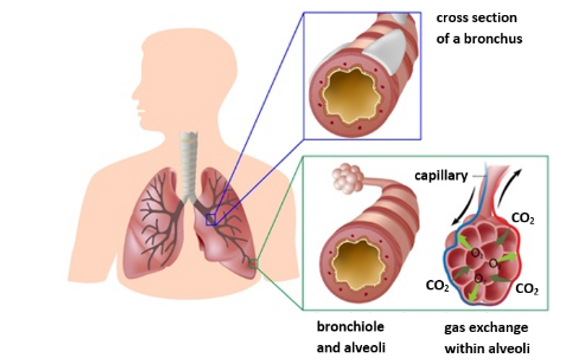The alveoli are small air sacs that are located in the lungs. They are especially adapted for the rapid exchange of gases in the lungs. The diagram below illustrates what alveoli look like and where they are located.

There are approximately 700,000,000 alveoli in two human lungs. This gives a total surface area of 60m2. Air is exchanged across the alveoli through the process of diffusion. Because there are so many alveoli, they give the lungs a significantly large surface area, allowing for a greater amount of gas exchange.
Alveoli have moist walls that are only one cell thick which makes the exchange surface very thin and the process of diffusion much quicker.
Capillaries are the body’s smallest blood vessel; they too are only one cell thick. Alveoli are surrounded by blood capillaries which ensures they have a good blood supply. Capillaries in the lungs allow for the transfer of oxygen into the bloodstream which then travel to all the other cells and organs of the body.
The below table lists the different gases and their amounts in atmospheric air compared to air that is exhaled from the body.
| Gas | Atmospheric air (%) | Exhaled air (%) |
| Nitrogen | 78 | 79 |
| Oxygen | 21 | 16 |
| Carbon dioxide | 0.04 | 4 |
| Other gases (e.g. argon) | 1 | 1 |
Exhaled air is saturated with water vapour and is warmer than atmospheric air. Different weather conditions can affect the amount of water vapour in the atmosphere.
As previously mentioned, the alveoli are responsible for absorbing oxygen into the blood and removing carbon dioxide from it. The lungs’ large surface area and the moist walls of the alveoli that are only one cell thick allow this to be done successfully. The following diagram provides you with a closer look at alveoli and the capillaries.




